As more people seek self-sufficiency and a closer connection to nature, off-grid living has gained significant popularity. This lifestyle choice involves disconnecting from public utilities and embracing a more sustainable, independent way of life. Off-grid houses aren’t limited to log cabins in the woods. Today’s sustainability enthusiasts are exploring a wide range of alternative off-grid homes that challenge the status quo, redefine sustainability, and pave the way for a more conscientious way of living.
Delve into the world of alternative off-grid homes. These unconventional homes offer innovative solutions for those looking to live sustainably while breaking free from the traditional housing mould. By exploring these diverse options, you can see how sustainable, off-grid living is evolving. It is possible to meet the needs of modern life without compromising on your commitment to the environment. Whether you are considering a complete lifestyle change or simply interested in sustainable architecture, this guide will introduce you to the exciting possibilities of alternative off-grid homes.
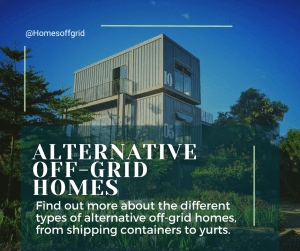
Understanding Alternative Off-Grid Homes
What are Alternative Off-Grid Homes?
Off-grid homes refer to living spaces that operate independently of public utilities like electricity, water, and sewage systems. Unlike traditional houses, these homes rely on self-sufficient systems for energy, water, and waste management. While many choose to convert a traditional house to go off-grid others prefer something a little more alternative. This category includes a variety of structures, from tiny homes and yurts to repurposed shipping containers and Earthships. What unites these diverse housing options is their ability to provide shelter while operating sustainably off the grid, often in harmony with the surrounding environment.
Advantages Over Traditional Homes
Choosing an alternative off-grid home offers numerous benefits, especially for those looking to embrace a simpler, more sustainable lifestyle. These homes are often more affordable to build and maintain, as they require fewer materials and rely on renewable energy. For instance, tiny homes and yurts are designed to maximise space efficiency, reducing the need for large plots of land and extensive resources. Shipping containers and Earthships, on the other hand, make use of recycled materials, turning waste into functional living spaces.
Another significant advantage is the flexibility and mobility that many alternative homes provide. Tiny homes, yurts, and shipping container homes can be relocated if needed, offering the freedom to live in various environments without being tied to a permanent foundation. This mobility is particularly appealing for those who desire a semi-nomadic lifestyle.
Importance of Sustainability in Off-Grid Homes
Sustainability is at the heart of off-grid homes, whether you have a traditional or alternative home. These homes are designed to minimise environmental impact by reducing reliance on non-renewable resources and lowering carbon footprints. Whether through the use of solar panels, rainwater harvesting systems, or composting toilets, off-grid homes often incorporate eco-friendly technologies that allow you to live comfortably while conserving natural resources.
Living in a sustainable, off-grid home also encourages a deeper connection with nature and a greater awareness of resource consumption. By choosing materials that are local, renewable, or recycled, and by adopting practices that promote energy efficiency and waste reduction, you contribute to a healthier planet while enjoying a lifestyle that is both fulfilling and self-sufficient.
Tiny Homes
Compact and Sustainable Living
Tiny homes are compact, efficient living spaces that typically under 120 metres or (400 feet) squared. Designed to maximise every inch of space, these homes often incorporate multi-functional furniture, clever storage solutions, and minimalist design principles. Tiny homes are especially appealing for off-grid living due to their low energy requirements and reduced environmental footprint. Many tiny homes are built on trailers, making them mobile and allowing you to live in various locations, further enhancing their appeal for those seeking a flexible, sustainable lifestyle.
Benefits of Tiny Homes for Off-Grid Living
The environmental, financial, and lifestyle benefits of tiny homes make them an ideal choice for off-grid living. Their small size means they consume far fewer resources than a traditional home, both in construction and day-to-day energy use. Many are equipped with solar panels, composting toilets, and rainwater harvesting systems, allowing you to live sustainably without sacrificing comfort.
Financially, tiny homes are generally more affordable to build and maintain. The cost of materials is lower, and with less space to heat, cool, and power, utility expenses are minimal. This affordability makes tiny homes accessible to a broader range of people, particularly those looking to downsize or live a debt-free lifestyle.
From a lifestyle perspective, tiny homes encourage a simpler, more intentional way of living. The limited space requires a decluttered, minimalist approach, which can lead to a greater focus on experiences rather than possessions. This simplicity, combined with the ability to move your home, offers unparalleled freedom and the opportunity to live closer to nature, aligning perfectly with the principles of off-grid living.
Design Innovations and Creative Uses of Space
One of the most remarkable aspects of tiny homes is the creativity and innovation involved in their design. Every section is carefully considered to ensure that the space is functional and comfortable. Lofted sleeping areas, fold-out furniture, and built-in storage solutions are common features that make tiny homes highly efficient. Some designs also incorporate sliding walls or modular components that can be rearranged to suit different needs, allowing the space to adapt to various activities throughout the day.
Innovative use of materials is another hallmark of tiny home design. Many builders opt for sustainable, recycled, or repurposed materials to further reduce the environmental impact. Large windows, skylights, and open floor plans help create a sense of spaciousness despite the limited dimensions. This ensures that living in a tiny home feels comfortable and inviting rather than cramped.
By embracing these design innovations and the creative use of space, tiny homes demonstrate that living sustainably off-grid doesn’t require sacrificing comfort or style. Instead, they offer a practical, eco-friendly solution.
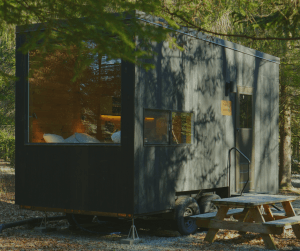
Converted Shipping Containers
Repurposed Shipping Containers as Off-Grid Homes
Shipping containers, once used solely for transporting goods across oceans, have been creatively repurposed as off-grid homes in recent years. These steel structures are being transformed into functional living spaces that challenge traditional ideas of what a home should be. The concept of converting shipping containers into homes is a testament to innovative thinking and sustainability. By reusing these containers, you’re not only giving them a second life but also reducing the demand for conventional building materials, making them an environmentally conscious choice for off-grid living.
Advantages of Using Shipping Containers
Using shipping containers as off-grid homes comes with several key advantages. Built to withstand harsh oceanic conditions, these containers are made from high-quality steel, providing a robust and secure structure. This durability makes them especially suitable for off-grid locations where weather conditions can be unpredictable.
Affordability is another significant benefit. Shipping containers are often available at a lower cost compared to traditional building materials, and their modular nature allows for a quicker, more cost-effective construction process. With a container home, you can achieve a modern, stylish living space without the hefty price tag of conventional homes.
Mobility is a unique advantage that shipping container homes offer. Like tiny homes, they can be relocated with relative ease, making them ideal for those who prefer a nomadic lifestyle or need a temporary housing solution while developing a more permanent off-grid dwelling. This flexibility enables you to explore different environments and live closer to nature without being tied to a single location.
Innovative Designs and Customisation Possibilities
The versatility of shipping containers allows for endless design possibilities, enabling you to create a home that suits your specific needs and aesthetic preferences. Containers can be stacked, combined, and customised to form unique layouts. You can create anything from single-container studios to multi-container homes with separate living areas. This modular approach offers flexibility in design, allowing for expansion or modification as your needs change.
Innovative designs often incorporate large windows, skylights, and open-plan interiors. These features help to counteract the industrial feel of the containers and create bright, welcoming spaces. Insulation and cladding are essential in transforming the steel structure into a comfortable living environment, with many opting for eco-friendly materials to maintain the sustainability of the build.
Customisation extends beyond the structure itself. Off-grid shipping container homes can be equipped with solar panels, green roofs, rainwater harvesting systems, and energy-efficient appliances. They can be designed to be as eco-friendly and sustainable as possible. Whether you’re seeking a minimalist retreat or a fully equipped family home, the adaptability of shipping containers makes them a compelling choice for alternative off-grid homes, blending urban design with the freedom of off-grid living.
Yurts
A Traditional Yet Alternative Off-Grid Home Option
Yurts are circular, portable structures with a rich history, originating from the nomadic cultures of Central Asia. Traditionally made from a wooden frame covered with felt or canvas, yurts are designed to be easily assembled and disassembled. This makes them an ideal choice for those living off-grid. While maintaining their ancient charm, modern yurts have been adapted with contemporary materials and designs, making them not only a nod to tradition but also a viable and appealing option for sustainable, off-grid living today.
Cultural Significance and Adaptability of Yurts
Yurts carry deep cultural significance, symbolising a way of life that is closely connected to nature and the environment. In their traditional use, yurts were more than just shelters; they were integral to the nomadic lifestyle, fostering a sense of community and harmony with the natural world. This cultural heritage adds a unique dimension to living in a yurt today. It offers a connection to ancient practices that emphasise simplicity, sustainability, and respect for the environment.
In modern off-grid scenarios, yurts have proven to be remarkably adaptable. They can be used as homes, studios, or even holiday retreats, making them suitable for a wide range of purposes. With modern adaptations, such as insulated walls, wood-burning stoves, and advanced waterproof materials, yurts can be comfortably used year-round, even in harsher climates.
Sustainability and Versatility
Yurts are inherently sustainable due to their minimal environmental impact. Their construction requires fewer materials compared to conventional homes. Also because they can be set up without a permanent foundation, the land remains largely undisturbed. The circular design of yurts promotes energy efficiency, allowing for more even heating and cooling. This reduces the need for artificial climate control. Many yurts can be equipped with solar panels, composting toilets, and rainwater harvesting systems, further enhancing their suitability for off-grid living.
Versatility is another key advantage of yurt living. Their portable nature allows you to relocate with relative ease, whether you want to explore different environments or simply need a temporary shelter while building a more permanent structure. Yurts can also be customised in various sizes. From small, cosy spaces to larger, multi-room dwellings, they are adaptable to different needs and lifestyles. This flexibility, along with their eco-friendly design, makes yurts an attractive option for those seeking a balance between traditional living and modern sustainability.
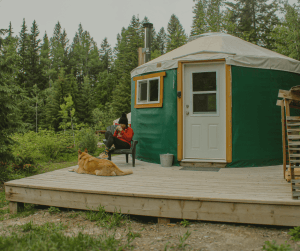
Sustainable Earthen Dwellings
Adobe and Strawbale Off-Grid Houses
Strawbale and adobe houses are two time-honoured methods of building with natural materials. Both methods offer sustainable and environmentally friendly solutions for off-grid living. Adobe houses, made from a mix of clay, sand, straw, and water, are constructed by forming sun-dried bricks that are stacked to create sturdy, earthen walls. Strawbale construction involves stacking compacted straw bales for structure and insulation, and then coating them with plaster or clay. Both techniques have deep historical roots and are particularly well-suited to creating comfortable, energy-efficient homes that integrate seamlessly with their natural surroundings.
Sustainability Features and Benefits
Both natural constructions offer significant sustainability benefits due to their reliance on locally sourced, renewable materials. Adobe’s primary sustainability feature lies in its thermal mass, which naturally regulates indoor temperatures by absorbing heat during the day and releasing it slowly at night. This quality reduces the need for artificial heating and cooling, thereby lowering energy consumption. Additionally, the materials used in adobe construction are entirely biodegradable, further reducing environmental impact.
Strawbale houses also excel in sustainability, primarily through their excellent insulation properties. The dense straw bales create thick walls that provide exceptional thermal resistance, keeping interiors warm in the winter and cool in the summer. This natural insulation dramatically reduces the need for energy-intensive climate control, making strawbale homes particularly efficient for off-grid living. Moreover, straw is a byproduct of agriculture, making it a readily available and renewable resource that promotes waste reduction by repurposing material that might otherwise be discarded.
Adaptability and Climate Considerations
Both adobe and strawbale homes are highly adaptable and can be tailored to a variety of climates and personal preferences. Adobe is particularly well-suited to arid regions, where its thermal mass properties are most effective. However, in wetter climates, additional protective measures, such as raised foundations and waterproof coatings, are necessary to safeguard the structure from moisture damage.
Strawbale construction is versatile across different climates but also requires careful attention to moisture control, as straw is susceptible to rot if not properly protected. In drier climates, strawbale walls can last for decades with minimal maintenance. Meanwhile, in more humid environments, well-designed roofs, breathable plasters, and proper site drainage are essential to ensure the longevity of the building.
Both building techniques offer ample opportunity for customisation, from traditional designs that reflect cultural heritage to modern, innovative architectural styles. The flexibility in design allows for the incorporation of features such as curved walls, vaulted ceilings, and artistic finishes. These enhance the aesthetic appeal and functionality of the home and allow for complete creativity. By carefully considering the local climate and adapting the design to suit specific environmental conditions, you can create a sustainable, comfortable, and resilient off-grid dwelling that embodies both traditional and modern sustainability principles.
Earthships
Unique Recycled Homes
Earthships are a revolutionary form of sustainable housing that embody the principles of self-sufficiency. Originally conceptualised in the 1970s, Earthships are designed to function entirely off-grid. They use natural and recycled materials, creating homes that are not only eco-friendly but also capable of providing for their inhabitants’ basic needs, such as energy, water, and food. These distinctive homes are typically built into the earth or utilise earth berming. This helps regulate temperature and integrates the structure seamlessly with the landscape. Earthships stand out as one of the most innovative and holistic approaches to sustainable living, offering a model for those seeking to minimise their environmental impact while maintaining a high quality of life.
Principles and Features of Earthship Construction
Earthships are founded on several core principles that make them unique among alternative home options. One of the key features is the use of recycled materials in construction. Earthships often incorporate tyres filled with rammed earth, which are stacked to form the thick, insulated walls of the structure. Other recycled materials, such as glass bottles, aluminium cans, and reclaimed wood, are also commonly used, reducing waste and promoting resourcefulness in building practices.
Another fundamental principle of Earthship design is passive solar heating and cooling. Earthships are typically oriented to maximise exposure to the sun, with large south-facing windows that allow sunlight to heat the interior during the winter months. The thick, earth-filled walls and floors act as thermal mass, absorbing and storing heat, which is then gradually released as temperatures drop. This passive solar design reduces the need for conventional heating and cooling systems, making Earthships incredibly energy efficient.
Water management is another critical feature of Earthships, which are designed to harvest, store, and recycle water on-site. Rainwater is collected from the roof and stored in cisterns, while greywater from sinks and showers is filtered and reused for irrigation or in toilet systems. These self-contained water systems are particularly valuable for off-grid living, where access to municipal water supplies may be limited or non-existent.
Self-Sufficiency and Eco-Friendly Living
The self-sufficiency offered by Earthships is one of their most compelling aspects. These homes are designed to operate independently of public utilities, relying instead on renewable energy sources such as solar and wind power. This autonomy not only reduces the environmental impact but also provides a sense of security and resilience, especially in remote or disaster-prone areas.
In addition to energy self-sufficiency, Earthships are designed to support food production. Many Earthships include indoor greenhouses, known as “biospheres,” where residents can grow fruits, vegetables, and herbs year-round. These greenhouses are integrated into the home’s water and climate control systems, ensuring a stable growing environment that reduces the need for external food sources.
Living in an Earthship also creates a closer connection to the environment and a greater awareness of resource consumption. The design encourages residents to connect with nature, whether through the careful management of water, energy, or food production. This lifestyle not only promotes environmental stewardship but also offers a fulfilling, self-reliant way of life that aligns with the principles of sustainability. The Earthship approach to housing challenges conventional notions of homebuilding and offers a visionary path towards a more sustainable and self-sufficient future.

Choosing Alternative Off-Grid Homes
Before Opting for Unconventional Housing
Choosing an alternative off-grid home involves a variety of practical considerations that are crucial for ensuring a successful transition to this lifestyle. Firstly, you need to assess your location carefully. The suitability of certain types of off-grid homes, such as Earthships or yurts, can vary depending on the climate, terrain, and local building regulations. It’s also important to investigate planning regulations and obtain the necessary permits. Some areas may have restrictions on unconventional housing types.
Another key factor is access to resources. Consider how you will obtain essential utilities like water, energy, and waste disposal. Off-grid living often requires investment in renewable energy systems, such as solar panels or wind turbines, and a reliable water source, whether through rainwater harvesting or a nearby well or spring. Additionally, consider the initial costs, as some alternative home options may require significant upfront investments in specialised materials or technology.
Maintenance is also an important consideration. Alternative off-grid homes, particularly those made from unconventional materials, may require specific upkeep that differs from traditional homes. Understanding these maintenance needs in advance will help you prepare for the long-term sustainability of your chosen housing option.
Eco-Friendly Features to Prioritise
When selecting an alternative off-grid home, prioritising sustainability is key. Focus on housing options that minimise environmental impact, both in their construction and in their ongoing operation. Materials should be sourced responsibly, with a preference for recycled, renewable, or locally available options. For instance, Earthships make extensive use of recycled materials, while strawbale homes utilise natural, biodegradable materials.
Energy efficiency is another critical factor. Look for homes that incorporate passive solar design, high levels of insulation, and energy-efficient appliances. Off-grid homes should ideally be able to generate their own energy through renewable sources, such as solar or wind, and should have systems in place for water conservation, such as greywater recycling and rainwater harvesting.
The ability to grow food is also a valuable feature in sustainable off-grid homes. Integrating a garden, greenhouse, or indoor growing space can enhance your self-sufficiency and reduce reliance on external food sources.
Personal Preferences and Lifestyle Factors
Your personal preferences and lifestyle will play a significant role in determining the best alternative off-grid home option for you. Consider the amount of space you need and how you intend to use it. For example, a tiny home might be perfect if you prefer minimalist living, while a modular, converted shipping container home could offer more space and flexibility.
Mobility is another lifestyle factor to consider. If you value the ability to relocate easily, a tiny home or yurt might be ideal. Conversely, if you’re looking for a more permanent structure, something like an Earthship or adobe house could be more suitable.
Comfort and aesthetics are also important. Different housing types offer different levels of comfort and design possibilities. While some might enjoy the rustic charm of a yurt, others might prefer the modern, industrial feel of a shipping container home. Ultimately, your choice should reflect your personal tastes and how you envision your day-to-day life in an off-grid setting.
Challenges and Solutions in Alternative Off-Grid Homes
Common Challenges
Living in an alternative off-grid home comes with its own set of challenges. One of the most common issues is the availability of resources. Off-grid homes require independent systems for energy, water, and waste management, which can be complex to install and maintain. You may face difficulties in ensuring a reliable energy supply, particularly in areas with limited sunlight or wind, which are crucial for solar and wind power systems.
Another challenge is the isolation that can come with living off-grid, particularly in remote locations. Limited access to emergency services, healthcare, and social amenities can be a concern. This is especially true for those who are used to more urban environments. Additionally, unconventional homes may not always meet local building codes or zoning laws, leading to potential legal and regulatory hurdles.
Solutions and Strategies to Overcome Obstacles
To overcome these challenges, innovative solutions and strategies are essential. For energy reliability, consider hybrid systems that combine solar, wind, and backup generators to ensure a steady supply of power. Battery storage systems can also help store excess energy for use during periods of low generation.
Water scarcity can be addressed through advanced rainwater harvesting systems and water conservation techniques, such as low-flow fixtures and greywater recycling. For waste management, composting toilets and septic systems designed for off-grid use can be effective solutions.
To tackle isolation, building a strong network with nearby off-grid communities can provide support and shared resources. Additionally, investing in satellite communication systems can help maintain connectivity. This ensures access to emergency services and staying in touch with loved ones.
Adaptability in Unconventional Living Spaces
Adaptability is crucial when transitioning to alternative off-grid homes. Unconventional homes often require a steep learning curve, particularly when it comes to managing self-sufficient systems. Being open to learning new skills, such as maintaining renewable energy systems or growing your own food, is essential for long-term success.
Patience and flexibility are also important. You may need to adjust expectations and lifestyle choices to go off-grid, which can be both rewarding and challenging. Embracing this adaptability will not only help you overcome the initial hurdles but also enhance your overall experience, leading to a more fulfilling and sustainable way of life in your chosen off-grid home.
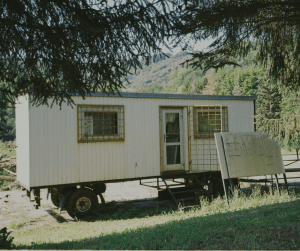
The Future of Sustainable Off-Grid Homes
The Predicted Evolution of Alternative Off-Grid Homes
The landscape of sustainable off-grid homes is set to evolve significantly in the coming years. This is being driven by advancements in technology, growing environmental awareness, and the increasing need for self-sufficiency. One of the key trends is the rise of smart off-grid homes. Cutting-edge technologies like AI-driven energy management systems and smart appliances optimise resource use and enhance sustainability. These homes already feature advanced monitoring systems that allow residents to track energy consumption, water usage, and waste management in real-time, further reducing their environmental footprint.
Another emerging trend is the blending of traditional and modern building techniques. As more people seek sustainable living options, we are seeing a resurgence of ancient building practices. Methods such as adobe or strawbale construction are being combined with modern materials and technologies. This fusion offers the durability and eco-friendliness of traditional methods while incorporating the efficiency and comfort provided by contemporary advancements.
The growing popularity of modular and prefabricated homes also points to a future where sustainable off-grid housing is more accessible and customisable. These homes can be designed, manufactured, and assembled with a high degree of precision, reducing construction waste and allowing for greater flexibility in design. As demand increases, we can expect more innovative designs and materials that cater to the specific needs of off-grid living.
Sustainable Home Technology
Technological innovations are at the forefront of the future of off-grid housing, promising to make sustainable living more efficient and accessible. Advances in renewable energy technology will play a critical role in making off-grid homes truly self-sufficient. The development of next-generation batteries, capable of storing more energy for longer periods, will address one of the key challenges of off-grid living: reliable power supply.
Advancements in greywater recycling systems, water purification technologies, and rainwater harvesting will enable water needs to be managed more effectively. New materials and construction techniques, such as 3D printing and bio-based building materials, are also set to revolutionise sustainable housing. Construction time, costs, and environmental impact can all be reduced massively.
Additionally, the use of vertical gardens and aquaponics in home design is becoming widespread. This allows residents to grow their own food even in limited spaces. These innovations will make off-grid homes not just energy-efficient but also food-secure, further enhancing their sustainability.
Shaping the Future of Off-Grid Living
Alternative housing is poised to play a pivotal role in shaping the future of off-grid living. As global challenges such as climate change, urbanisation, and resource scarcity intensify, the need for different housing solutions that can operate independently of traditional infrastructure will become increasingly important. Off-grid homes demonstrate that it is possible to live sustainably and comfortably without relying on conventional utilities.
These housing options show how communities can thrive even in the face of environmental and economic uncertainties. By embracing unconventional homes, individuals and communities can reduce their dependence on external resources, lower their carbon footprint, and foster a deeper connection with the natural world.
As these concepts gain traction, they could inspire broader changes in how housing is designed and constructed, influencing everything from urban planning to building regulations. Unconventional housing could become a mainstream solution, offering an alternative path to sustainable living that is both innovative and practical.
Conclusion
Alternative off-grid homes present a compelling opportunity to embrace a more sustainable and self-sufficient lifestyle. From Earthships and yurts to shipping container homes and adobe houses, these unconventional housing options offer a range of possibilities for those seeking to reduce their environmental impact and live closer to nature.
The benefits of alternative off-grid homes are numerous, including greater energy independence, reduced reliance on public utilities, and the potential for a simpler, more intentional way of life. These homes challenge conventional notions of what a house should be. They offer a path towards a more sustainable future, where living in harmony with the environment is central.
The innovations and trends emerging in sustainable housing technology promise to make off-grid living more accessible and efficient. By exploring these options and embracing the principles of sustainability, you can play a part in shaping a future where homes are not just places to live, but also expressions of our commitment to the planet. Whether you’re motivated by environmental concerns, a desire for independence, or a pursuit of a simpler life, alternative off-grid homes offer a unique and rewarding path to sustainable living.
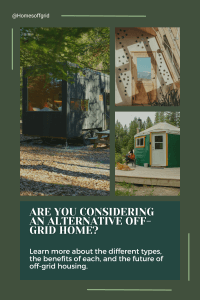
To find out more about off-grid living return to our Reading Room.


